Analyzing Business Environment: Organizational Functions and Impact
VerifiedAdded on 2024/05/30
|24
|5132
|174
Report
AI Summary
This report provides a comprehensive analysis of the business environment, focusing on different types of organizations (public, private, voluntary), their purposes, and legal structures. It explains the size and scope of various organizations and explores the relationship between different organizational functions and their link to organizational objectives and structure. The report also identifies the positive and negative impacts of the macro environment on business operations, supported by detailed examples. Furthermore, it conducts external and internal analyses of specific organizations to identify their strengths and weaknesses, explaining how these are interconnected with external macro factors, using Virgin Money as a case study with SWOT and TOWS analyses. The document is contributed by a student and available on Desklib, a platform offering study tools and past papers for students.
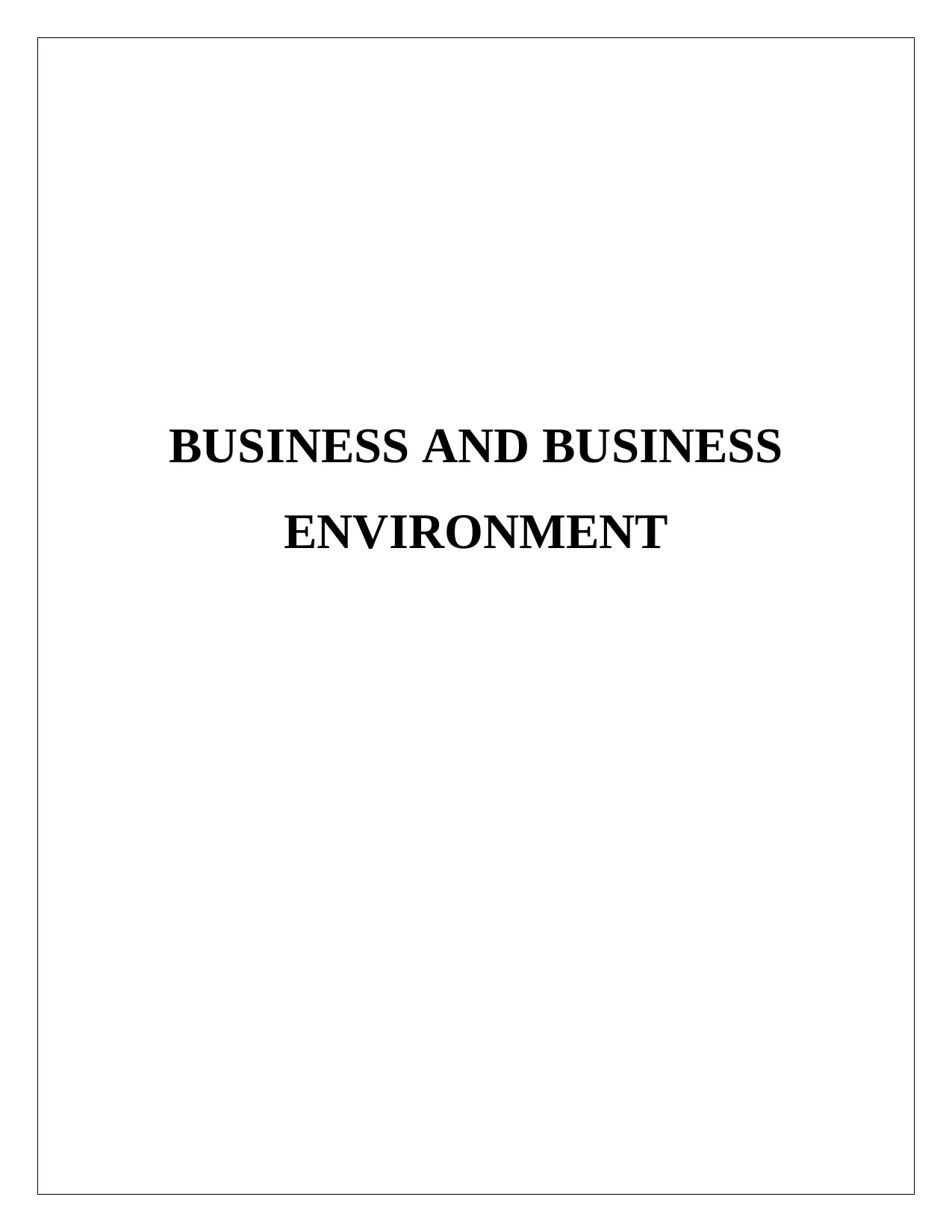
BUSINESS AND BUSINESS
ENVIRONMENT
ENVIRONMENT
Paraphrase This Document
Need a fresh take? Get an instant paraphrase of this document with our AI Paraphraser
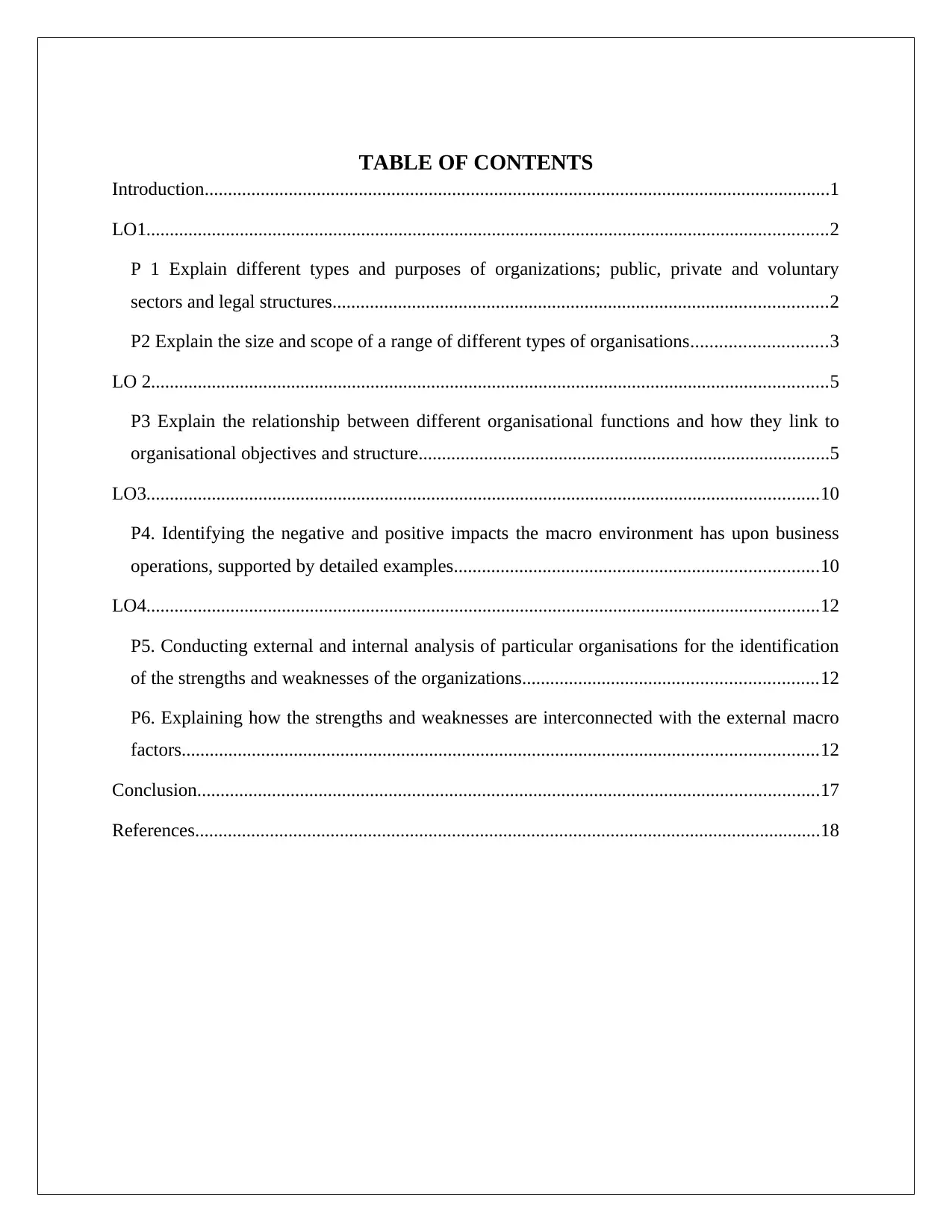
TABLE OF CONTENTS
Introduction......................................................................................................................................1
LO1..................................................................................................................................................2
P 1 Explain different types and purposes of organizations; public, private and voluntary
sectors and legal structures..........................................................................................................2
P2 Explain the size and scope of a range of different types of organisations.............................3
LO 2.................................................................................................................................................5
P3 Explain the relationship between different organisational functions and how they link to
organisational objectives and structure........................................................................................5
LO3................................................................................................................................................10
P4. Identifying the negative and positive impacts the macro environment has upon business
operations, supported by detailed examples..............................................................................10
LO4................................................................................................................................................12
P5. Conducting external and internal analysis of particular organisations for the identification
of the strengths and weaknesses of the organizations...............................................................12
P6. Explaining how the strengths and weaknesses are interconnected with the external macro
factors........................................................................................................................................12
Conclusion.....................................................................................................................................17
References......................................................................................................................................18
Introduction......................................................................................................................................1
LO1..................................................................................................................................................2
P 1 Explain different types and purposes of organizations; public, private and voluntary
sectors and legal structures..........................................................................................................2
P2 Explain the size and scope of a range of different types of organisations.............................3
LO 2.................................................................................................................................................5
P3 Explain the relationship between different organisational functions and how they link to
organisational objectives and structure........................................................................................5
LO3................................................................................................................................................10
P4. Identifying the negative and positive impacts the macro environment has upon business
operations, supported by detailed examples..............................................................................10
LO4................................................................................................................................................12
P5. Conducting external and internal analysis of particular organisations for the identification
of the strengths and weaknesses of the organizations...............................................................12
P6. Explaining how the strengths and weaknesses are interconnected with the external macro
factors........................................................................................................................................12
Conclusion.....................................................................................................................................17
References......................................................................................................................................18
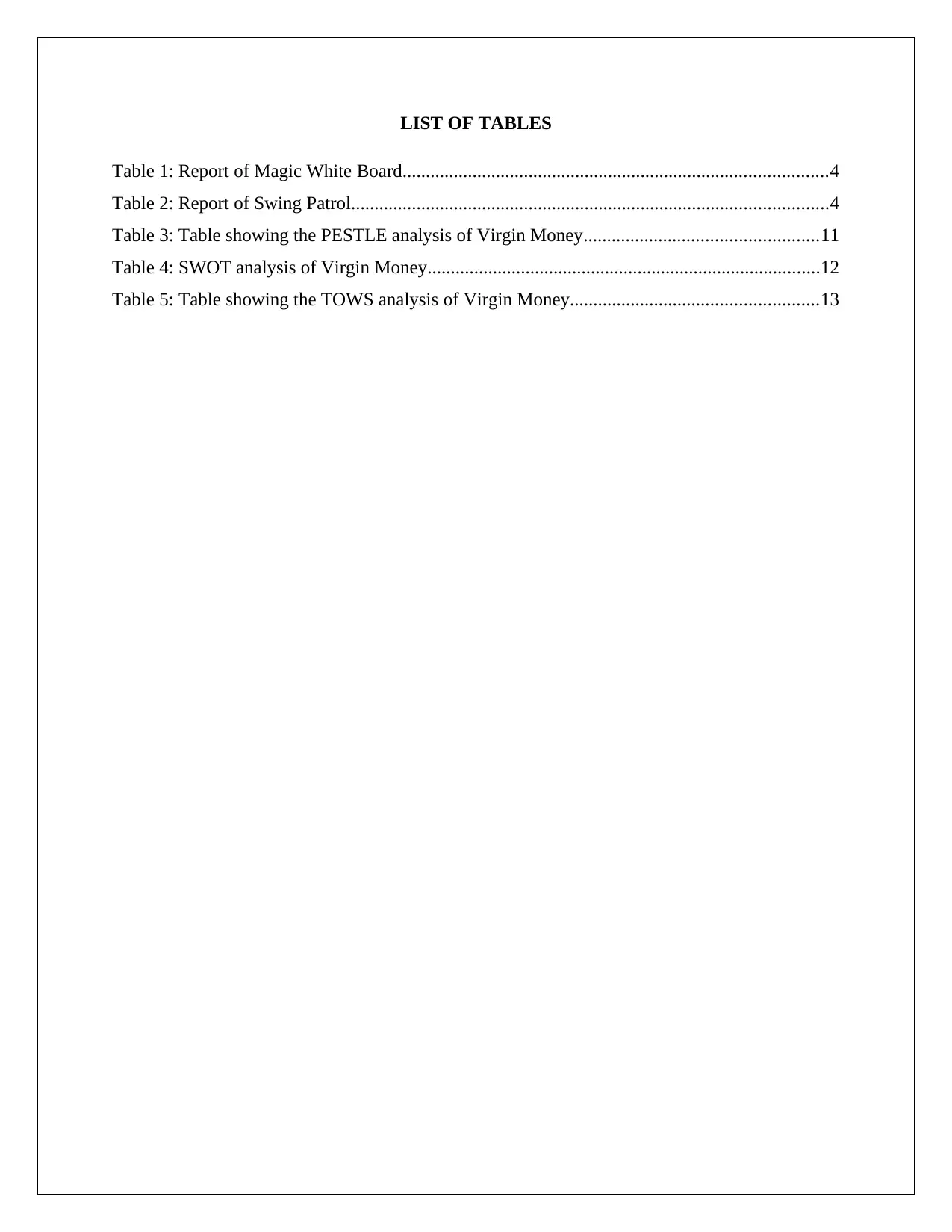
LIST OF TABLES
Table 1: Report of Magic White Board...........................................................................................4
Table 2: Report of Swing Patrol......................................................................................................4
Table 3: Table showing the PESTLE analysis of Virgin Money..................................................11
Table 4: SWOT analysis of Virgin Money....................................................................................12
Table 5: Table showing the TOWS analysis of Virgin Money.....................................................13
Table 1: Report of Magic White Board...........................................................................................4
Table 2: Report of Swing Patrol......................................................................................................4
Table 3: Table showing the PESTLE analysis of Virgin Money..................................................11
Table 4: SWOT analysis of Virgin Money....................................................................................12
Table 5: Table showing the TOWS analysis of Virgin Money.....................................................13
⊘ This is a preview!⊘
Do you want full access?
Subscribe today to unlock all pages.

Trusted by 1+ million students worldwide

LIST OF FIGURES
Figure 1: Statistics of profit generation of SMEs in UK.................................................................4
Figure 2: Functional organizational structure..................................................................................5
Figure 3: Functional organizational structure..................................................................................6
Figure 4: Matrix organizational structure........................................................................................7
Figure 5: Figure showing the TOWS matrix and its elements......................................................13
Figure 1: Statistics of profit generation of SMEs in UK.................................................................4
Figure 2: Functional organizational structure..................................................................................5
Figure 3: Functional organizational structure..................................................................................6
Figure 4: Matrix organizational structure........................................................................................7
Figure 5: Figure showing the TOWS matrix and its elements......................................................13
Paraphrase This Document
Need a fresh take? Get an instant paraphrase of this document with our AI Paraphraser

Introduction
Any organization, in order to improve the efficiency and productivity, needs to expand not only
in its own economy but globally. Various micro and macro factors affect this expansion process
of the organization and the business environment is concerned with the solutions to such micro
and macro problems. This business environment and the problems associated with it consider
various factors like the size of the business, the scope for its expansion, the innovation in the
product or service provided et al. Such business environment can have only two effects on the
current functioning are of the firm, either positive or negative. These factors and their effects can
be understood by the analysis of Virgin money through SWOT analysis which analyses both
micro and macro factors and brings out the strengths and weaknesses along with opportunities
threats of the organization.
1
Any organization, in order to improve the efficiency and productivity, needs to expand not only
in its own economy but globally. Various micro and macro factors affect this expansion process
of the organization and the business environment is concerned with the solutions to such micro
and macro problems. This business environment and the problems associated with it consider
various factors like the size of the business, the scope for its expansion, the innovation in the
product or service provided et al. Such business environment can have only two effects on the
current functioning are of the firm, either positive or negative. These factors and their effects can
be understood by the analysis of Virgin money through SWOT analysis which analyses both
micro and macro factors and brings out the strengths and weaknesses along with opportunities
threats of the organization.
1

LO1
P1 Explain different types and purposes of organizations; public, private and voluntary sectors
and legal structures
Introduction
In order to identify the problems in any organization, the first step is to analyse the type of the
organization, which can be profit or non-profit, big or small, etc. The classifications of
organizations can be done on the basis of function, structure, type, scope etc. which is described
as follows:
Differences between profit, not for profit and non-governmental organisations (NGOs)
Profit organizations: It can be defined as the organization which is endured with the sole
purpose to earn profit with the help of various stakeholders and owners (Arvidson and Lyon,
2014). The profit organizations focus on the needs of the market and satisfy those needs in
returns of profits for the organization.
Not for profit: It can be defined as the firms established with the purpose of providing services
and products to the public in order to induce development and welfare. Such a purpose of non-
profit organization helps the economy and hence government is mainly the initiator for such
organizations (Aldashev et.al. 2015). Even though the purpose of this organization is not to earn
profit a part of revenue has to be generated for the existence of the firm.
Non-governmental: It can be defined as the organization which is owned by individuals who are
not a part of the government body and are able to finance the organization through various means
without the help of the government officials. They focus on public welfare and practices.
Business purpose and supply of goods and services
The type of the business determines its purpose of existence and the types of goods or services
they provide to the society. For example the enduring purpose of a profit organization is to
generate as much profit as it can. The organization in this type of business is dependent on the
demand and supply of the market. For instance, in Marks and Spencer the production of various
2
P1 Explain different types and purposes of organizations; public, private and voluntary sectors
and legal structures
Introduction
In order to identify the problems in any organization, the first step is to analyse the type of the
organization, which can be profit or non-profit, big or small, etc. The classifications of
organizations can be done on the basis of function, structure, type, scope etc. which is described
as follows:
Differences between profit, not for profit and non-governmental organisations (NGOs)
Profit organizations: It can be defined as the organization which is endured with the sole
purpose to earn profit with the help of various stakeholders and owners (Arvidson and Lyon,
2014). The profit organizations focus on the needs of the market and satisfy those needs in
returns of profits for the organization.
Not for profit: It can be defined as the firms established with the purpose of providing services
and products to the public in order to induce development and welfare. Such a purpose of non-
profit organization helps the economy and hence government is mainly the initiator for such
organizations (Aldashev et.al. 2015). Even though the purpose of this organization is not to earn
profit a part of revenue has to be generated for the existence of the firm.
Non-governmental: It can be defined as the organization which is owned by individuals who are
not a part of the government body and are able to finance the organization through various means
without the help of the government officials. They focus on public welfare and practices.
Business purpose and supply of goods and services
The type of the business determines its purpose of existence and the types of goods or services
they provide to the society. For example the enduring purpose of a profit organization is to
generate as much profit as it can. The organization in this type of business is dependent on the
demand and supply of the market. For instance, in Marks and Spencer the production of various
2
⊘ This is a preview!⊘
Do you want full access?
Subscribe today to unlock all pages.

Trusted by 1+ million students worldwide
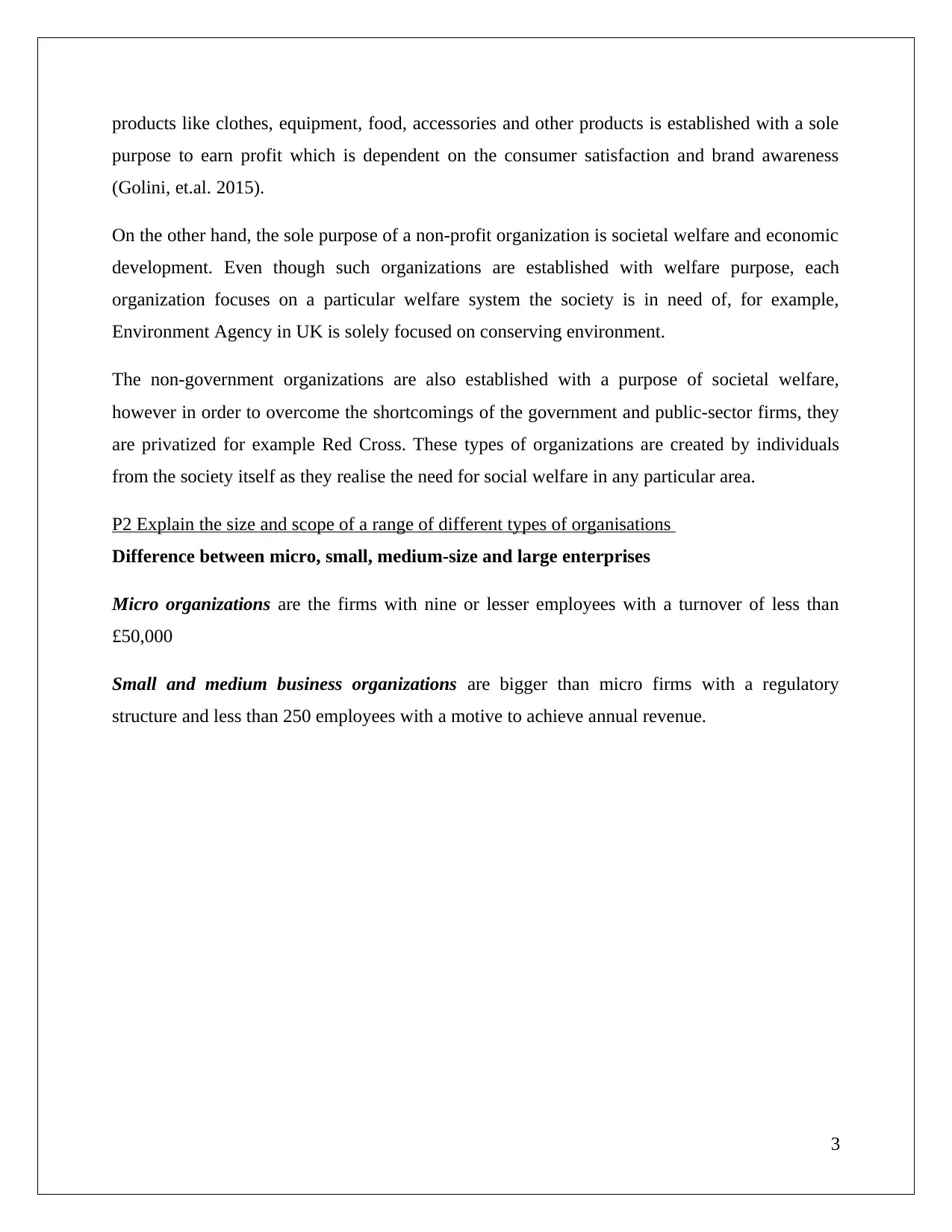
products like clothes, equipment, food, accessories and other products is established with a sole
purpose to earn profit which is dependent on the consumer satisfaction and brand awareness
(Golini, et.al. 2015).
On the other hand, the sole purpose of a non-profit organization is societal welfare and economic
development. Even though such organizations are established with welfare purpose, each
organization focuses on a particular welfare system the society is in need of, for example,
Environment Agency in UK is solely focused on conserving environment.
The non-government organizations are also established with a purpose of societal welfare,
however in order to overcome the shortcomings of the government and public-sector firms, they
are privatized for example Red Cross. These types of organizations are created by individuals
from the society itself as they realise the need for social welfare in any particular area.
P2 Explain the size and scope of a range of different types of organisations
Difference between micro, small, medium-size and large enterprises
Micro organizations are the firms with nine or lesser employees with a turnover of less than
£50,000
Small and medium business organizations are bigger than micro firms with a regulatory
structure and less than 250 employees with a motive to achieve annual revenue.
3
purpose to earn profit which is dependent on the consumer satisfaction and brand awareness
(Golini, et.al. 2015).
On the other hand, the sole purpose of a non-profit organization is societal welfare and economic
development. Even though such organizations are established with welfare purpose, each
organization focuses on a particular welfare system the society is in need of, for example,
Environment Agency in UK is solely focused on conserving environment.
The non-government organizations are also established with a purpose of societal welfare,
however in order to overcome the shortcomings of the government and public-sector firms, they
are privatized for example Red Cross. These types of organizations are created by individuals
from the society itself as they realise the need for social welfare in any particular area.
P2 Explain the size and scope of a range of different types of organisations
Difference between micro, small, medium-size and large enterprises
Micro organizations are the firms with nine or lesser employees with a turnover of less than
£50,000
Small and medium business organizations are bigger than micro firms with a regulatory
structure and less than 250 employees with a motive to achieve annual revenue.
3
Paraphrase This Document
Need a fresh take? Get an instant paraphrase of this document with our AI Paraphraser
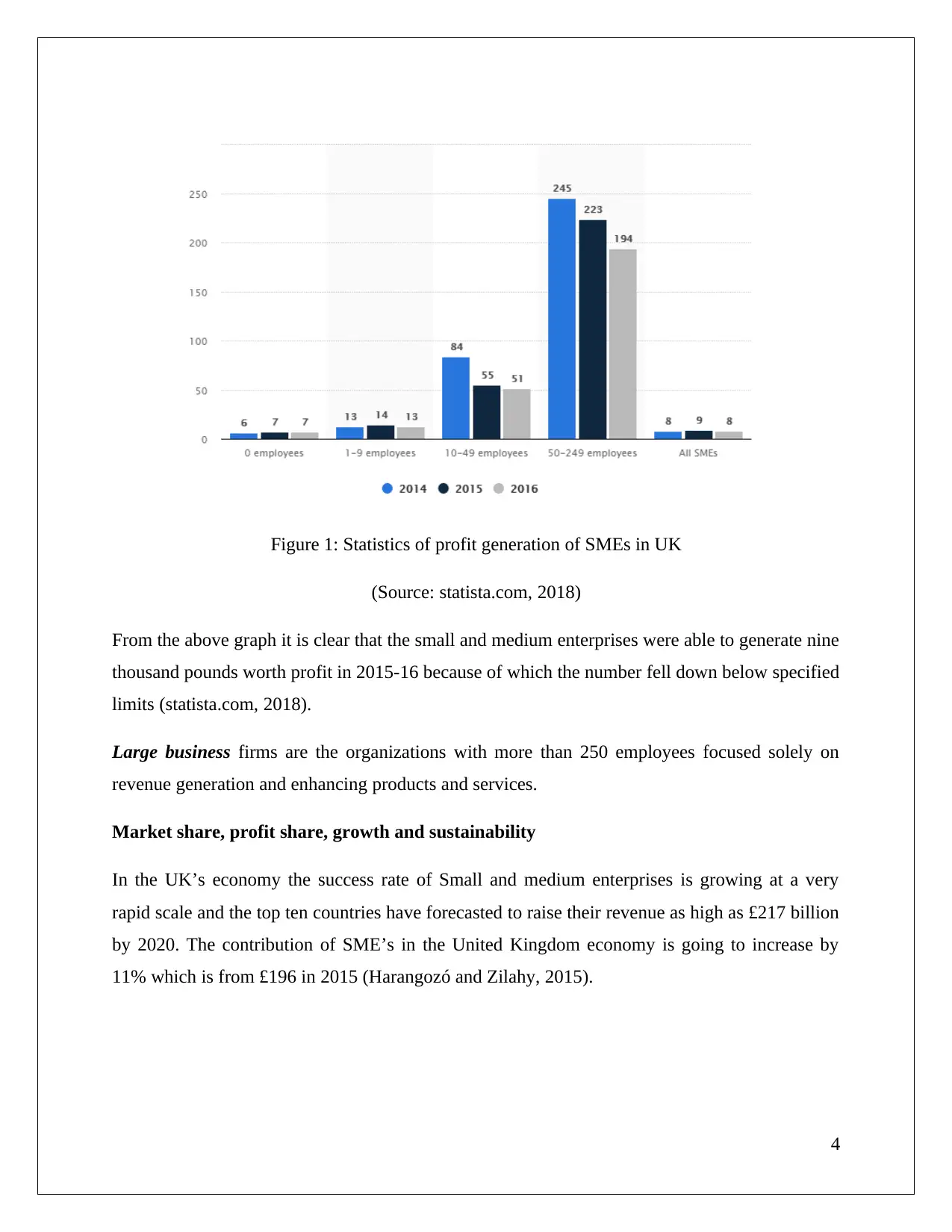
Figure 1: Statistics of profit generation of SMEs in UK
(Source: statista.com, 2018)
From the above graph it is clear that the small and medium enterprises were able to generate nine
thousand pounds worth profit in 2015-16 because of which the number fell down below specified
limits (statista.com, 2018).
Large business firms are the organizations with more than 250 employees focused solely on
revenue generation and enhancing products and services.
Market share, profit share, growth and sustainability
In the UK’s economy the success rate of Small and medium enterprises is growing at a very
rapid scale and the top ten countries have forecasted to raise their revenue as high as £217 billion
by 2020. The contribution of SME’s in the United Kingdom economy is going to increase by
11% which is from £196 in 2015 (Harangozó and Zilahy, 2015).
4
(Source: statista.com, 2018)
From the above graph it is clear that the small and medium enterprises were able to generate nine
thousand pounds worth profit in 2015-16 because of which the number fell down below specified
limits (statista.com, 2018).
Large business firms are the organizations with more than 250 employees focused solely on
revenue generation and enhancing products and services.
Market share, profit share, growth and sustainability
In the UK’s economy the success rate of Small and medium enterprises is growing at a very
rapid scale and the top ten countries have forecasted to raise their revenue as high as £217 billion
by 2020. The contribution of SME’s in the United Kingdom economy is going to increase by
11% which is from £196 in 2015 (Harangozó and Zilahy, 2015).
4
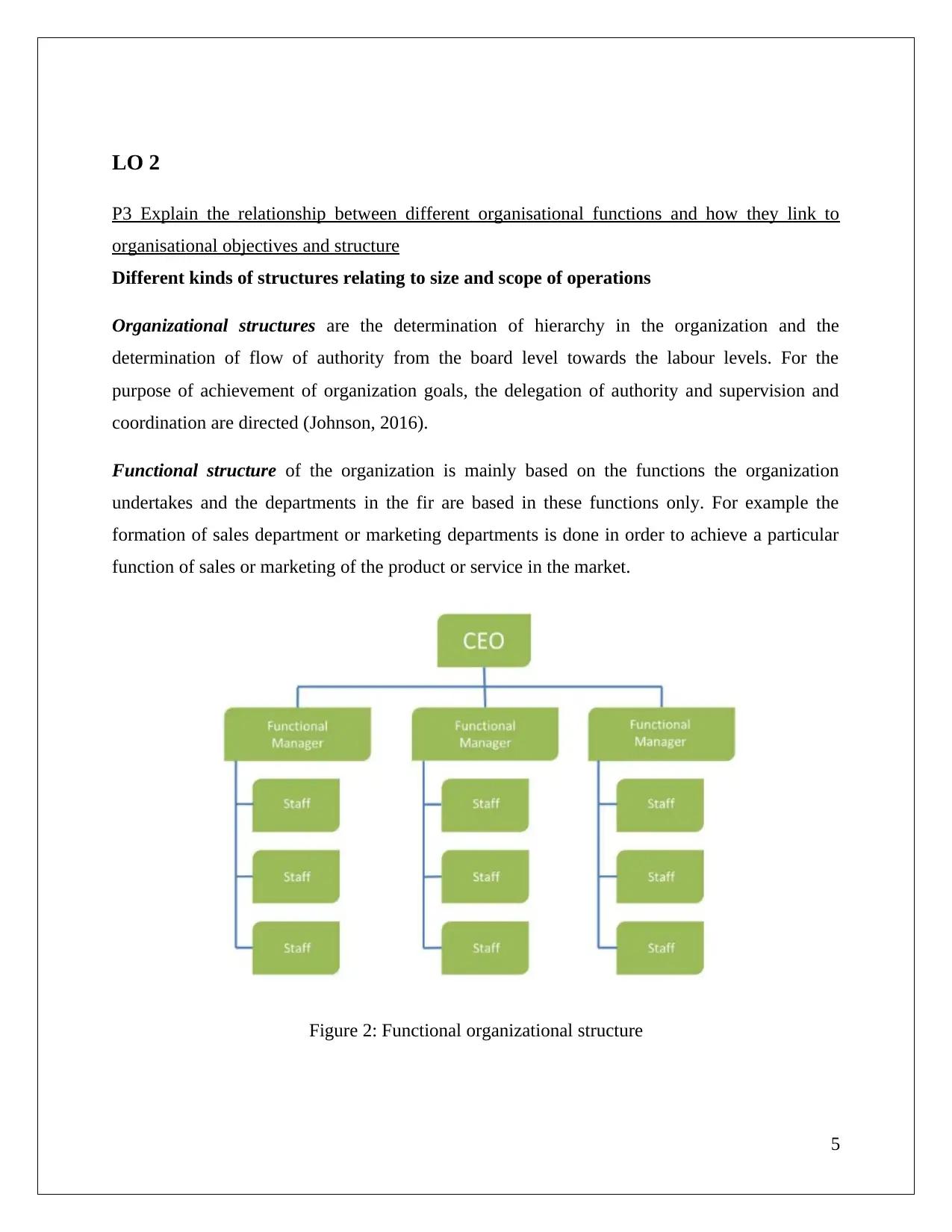
LO 2
P3 Explain the relationship between different organisational functions and how they link to
organisational objectives and structure
Different kinds of structures relating to size and scope of operations
Organizational structures are the determination of hierarchy in the organization and the
determination of flow of authority from the board level towards the labour levels. For the
purpose of achievement of organization goals, the delegation of authority and supervision and
coordination are directed (Johnson, 2016).
Functional structure of the organization is mainly based on the functions the organization
undertakes and the departments in the fir are based in these functions only. For example the
formation of sales department or marketing departments is done in order to achieve a particular
function of sales or marketing of the product or service in the market.
Figure 2: Functional organizational structure
5
P3 Explain the relationship between different organisational functions and how they link to
organisational objectives and structure
Different kinds of structures relating to size and scope of operations
Organizational structures are the determination of hierarchy in the organization and the
determination of flow of authority from the board level towards the labour levels. For the
purpose of achievement of organization goals, the delegation of authority and supervision and
coordination are directed (Johnson, 2016).
Functional structure of the organization is mainly based on the functions the organization
undertakes and the departments in the fir are based in these functions only. For example the
formation of sales department or marketing departments is done in order to achieve a particular
function of sales or marketing of the product or service in the market.
Figure 2: Functional organizational structure
5
⊘ This is a preview!⊘
Do you want full access?
Subscribe today to unlock all pages.

Trusted by 1+ million students worldwide
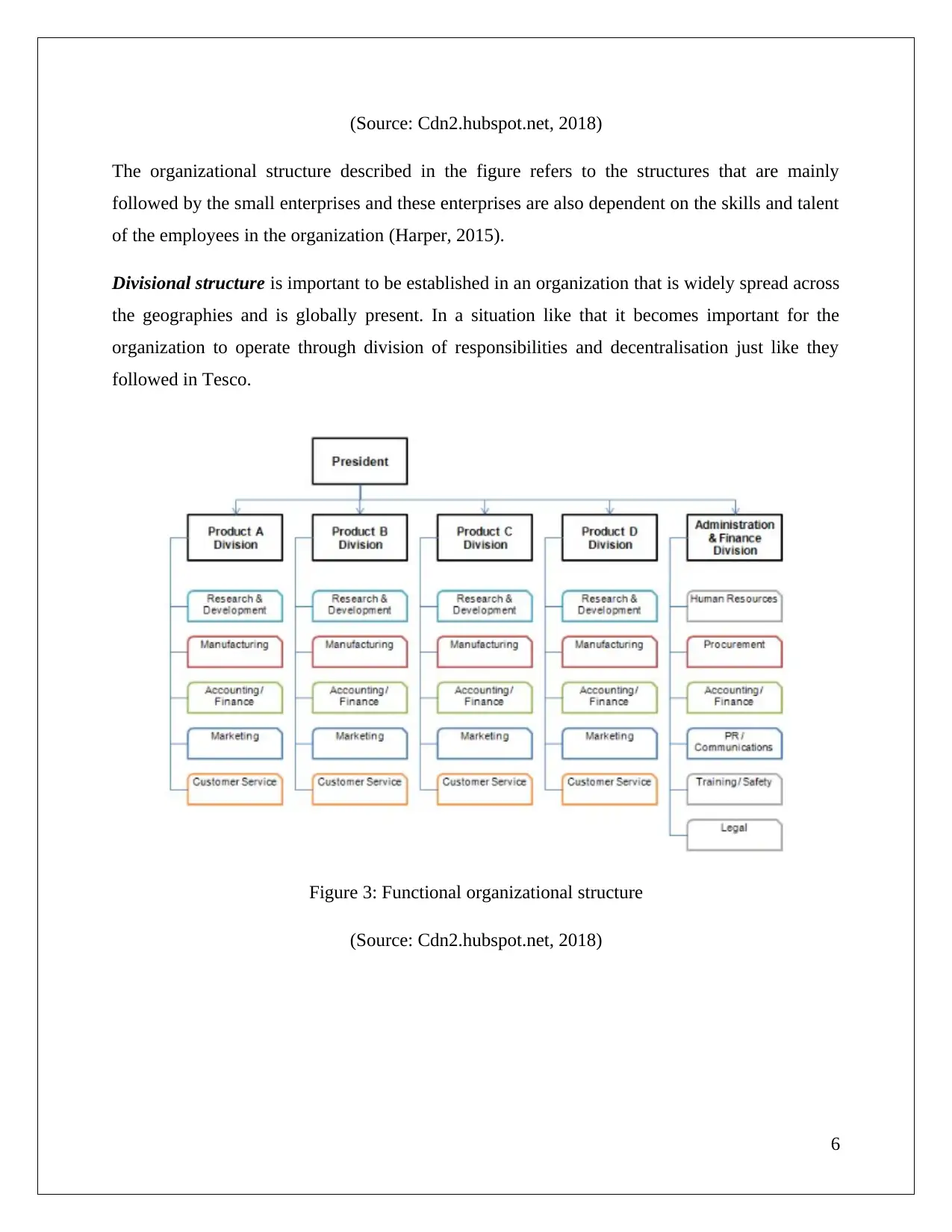
(Source: Cdn2.hubspot.net, 2018)
The organizational structure described in the figure refers to the structures that are mainly
followed by the small enterprises and these enterprises are also dependent on the skills and talent
of the employees in the organization (Harper, 2015).
Divisional structure is important to be established in an organization that is widely spread across
the geographies and is globally present. In a situation like that it becomes important for the
organization to operate through division of responsibilities and decentralisation just like they
followed in Tesco.
Figure 3: Functional organizational structure
(Source: Cdn2.hubspot.net, 2018)
6
The organizational structure described in the figure refers to the structures that are mainly
followed by the small enterprises and these enterprises are also dependent on the skills and talent
of the employees in the organization (Harper, 2015).
Divisional structure is important to be established in an organization that is widely spread across
the geographies and is globally present. In a situation like that it becomes important for the
organization to operate through division of responsibilities and decentralisation just like they
followed in Tesco.
Figure 3: Functional organizational structure
(Source: Cdn2.hubspot.net, 2018)
6
Paraphrase This Document
Need a fresh take? Get an instant paraphrase of this document with our AI Paraphraser

Matrix structure is considered a third main type of organizational structure, this structure is a
hybrid of functional and divisional structure.
Figure 4: Matrix organizational structure
(Source: Managementmania.com, 2018)
When a firm is grown to a stage of a multinational company and is present globally for example,
Starbucks, a structure like matrix organizational structure has to be followed. This is because
there are various problems faced if the firm has its presence globally like the control mechanisms
and changes of cultures in different economies and values of the organization cannot be observed
in a same manner everywhere (Bolman and Deal, 2017). Because of this various function of the
matrix structure that are observed are that it is a combination of functional and divisional
structure. This is also known as the dual management of the firm.
The firms which are huge like the British Gas, which require hierarchy and an incorporation of a
tall organization, it is important to develop a number of levels of organization which is possible
only through the matrix structure of organization.
Flat organizational structure refers to a small number of management levels which are easily
managed by the top level and consist of responsibilities and control at every level of
management.
7
hybrid of functional and divisional structure.
Figure 4: Matrix organizational structure
(Source: Managementmania.com, 2018)
When a firm is grown to a stage of a multinational company and is present globally for example,
Starbucks, a structure like matrix organizational structure has to be followed. This is because
there are various problems faced if the firm has its presence globally like the control mechanisms
and changes of cultures in different economies and values of the organization cannot be observed
in a same manner everywhere (Bolman and Deal, 2017). Because of this various function of the
matrix structure that are observed are that it is a combination of functional and divisional
structure. This is also known as the dual management of the firm.
The firms which are huge like the British Gas, which require hierarchy and an incorporation of a
tall organization, it is important to develop a number of levels of organization which is possible
only through the matrix structure of organization.
Flat organizational structure refers to a small number of management levels which are easily
managed by the top level and consist of responsibilities and control at every level of
management.
7
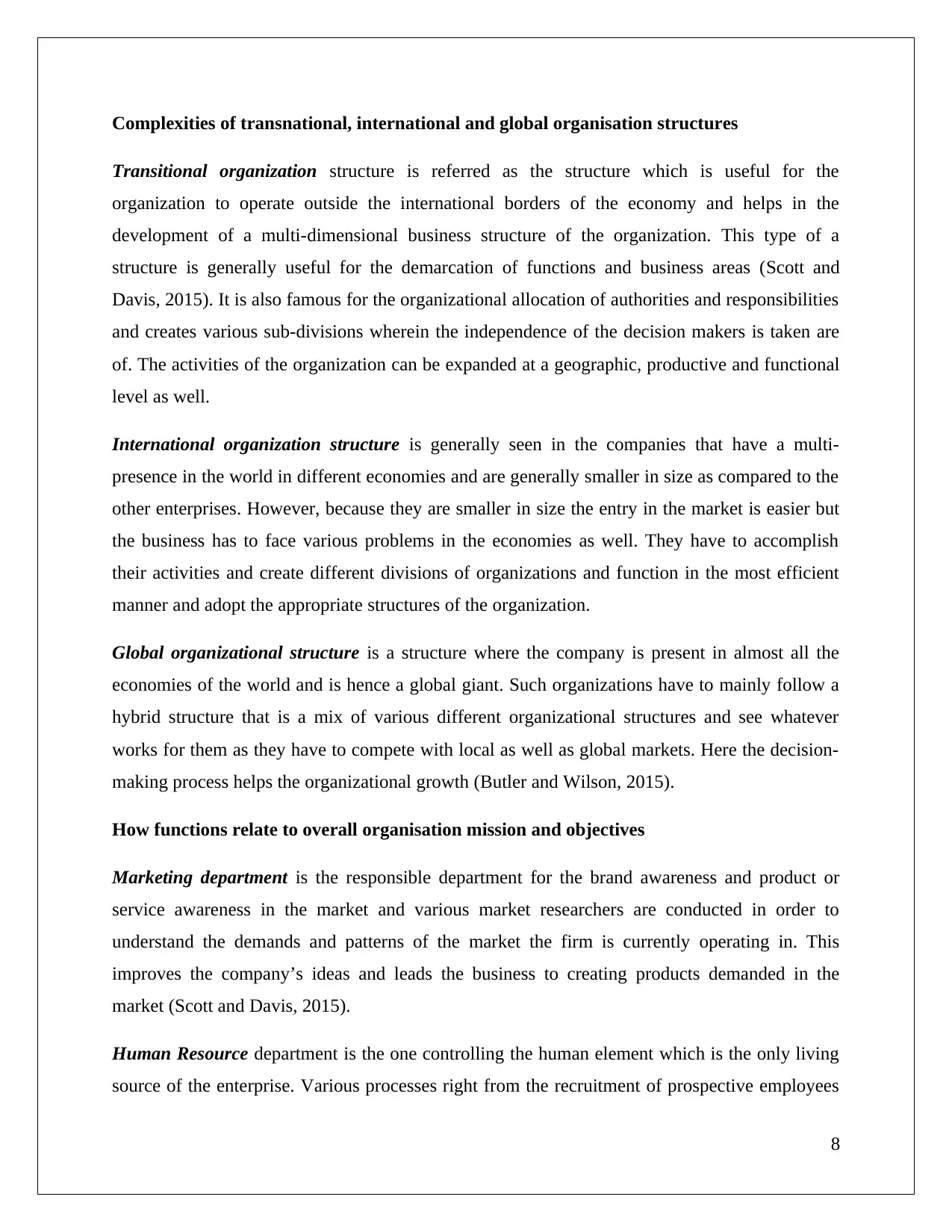
Complexities of transnational, international and global organisation structures
Transitional organization structure is referred as the structure which is useful for the
organization to operate outside the international borders of the economy and helps in the
development of a multi-dimensional business structure of the organization. This type of a
structure is generally useful for the demarcation of functions and business areas (Scott and
Davis, 2015). It is also famous for the organizational allocation of authorities and responsibilities
and creates various sub-divisions wherein the independence of the decision makers is taken are
of. The activities of the organization can be expanded at a geographic, productive and functional
level as well.
International organization structure is generally seen in the companies that have a multi-
presence in the world in different economies and are generally smaller in size as compared to the
other enterprises. However, because they are smaller in size the entry in the market is easier but
the business has to face various problems in the economies as well. They have to accomplish
their activities and create different divisions of organizations and function in the most efficient
manner and adopt the appropriate structures of the organization.
Global organizational structure is a structure where the company is present in almost all the
economies of the world and is hence a global giant. Such organizations have to mainly follow a
hybrid structure that is a mix of various different organizational structures and see whatever
works for them as they have to compete with local as well as global markets. Here the decision-
making process helps the organizational growth (Butler and Wilson, 2015).
How functions relate to overall organisation mission and objectives
Marketing department is the responsible department for the brand awareness and product or
service awareness in the market and various market researchers are conducted in order to
understand the demands and patterns of the market the firm is currently operating in. This
improves the company’s ideas and leads the business to creating products demanded in the
market (Scott and Davis, 2015).
Human Resource department is the one controlling the human element which is the only living
source of the enterprise. Various processes right from the recruitment of prospective employees
8
Transitional organization structure is referred as the structure which is useful for the
organization to operate outside the international borders of the economy and helps in the
development of a multi-dimensional business structure of the organization. This type of a
structure is generally useful for the demarcation of functions and business areas (Scott and
Davis, 2015). It is also famous for the organizational allocation of authorities and responsibilities
and creates various sub-divisions wherein the independence of the decision makers is taken are
of. The activities of the organization can be expanded at a geographic, productive and functional
level as well.
International organization structure is generally seen in the companies that have a multi-
presence in the world in different economies and are generally smaller in size as compared to the
other enterprises. However, because they are smaller in size the entry in the market is easier but
the business has to face various problems in the economies as well. They have to accomplish
their activities and create different divisions of organizations and function in the most efficient
manner and adopt the appropriate structures of the organization.
Global organizational structure is a structure where the company is present in almost all the
economies of the world and is hence a global giant. Such organizations have to mainly follow a
hybrid structure that is a mix of various different organizational structures and see whatever
works for them as they have to compete with local as well as global markets. Here the decision-
making process helps the organizational growth (Butler and Wilson, 2015).
How functions relate to overall organisation mission and objectives
Marketing department is the responsible department for the brand awareness and product or
service awareness in the market and various market researchers are conducted in order to
understand the demands and patterns of the market the firm is currently operating in. This
improves the company’s ideas and leads the business to creating products demanded in the
market (Scott and Davis, 2015).
Human Resource department is the one controlling the human element which is the only living
source of the enterprise. Various processes right from the recruitment of prospective employees
8
⊘ This is a preview!⊘
Do you want full access?
Subscribe today to unlock all pages.

Trusted by 1+ million students worldwide
1 out of 24
Related Documents
Your All-in-One AI-Powered Toolkit for Academic Success.
+13062052269
info@desklib.com
Available 24*7 on WhatsApp / Email
![[object Object]](/_next/static/media/star-bottom.7253800d.svg)
Unlock your academic potential
Copyright © 2020–2025 A2Z Services. All Rights Reserved. Developed and managed by ZUCOL.



